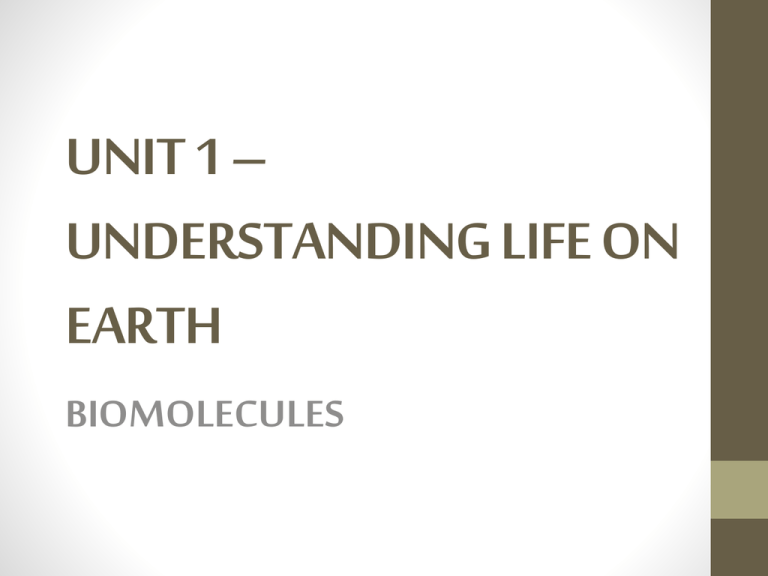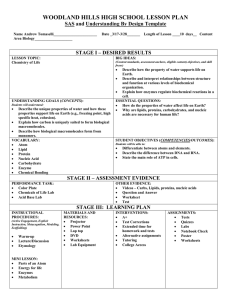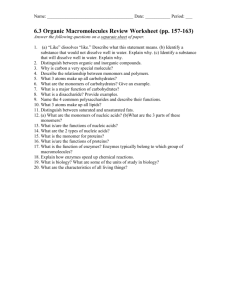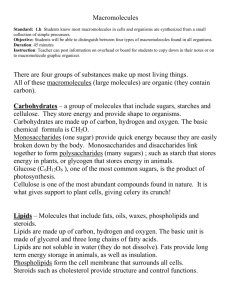What elements from the periodic table support all life on
advertisement

UNIT 1 – UNDERSTANDING LIFE ON EARTH BIOMOLECULES INTRO TO BIOCHEMISTRY What elements from the periodic table support all life on Earth? Answer: • CARBON • HYDROGEN • OXYGEN • NITROGEN • PHOSPHORUS 3 Carbon-based Molecules: Organic chemistry: study of carbon compounds Carbon has 4 electrons in an outer energy level that holds eight; Can form 4 covalent bonds with many other elements 4 Shape of Organic Molecules: shape=function The shape determines its function in an organism 5 Giant Molecules – Polymers: •Large molecules are called polymers • Monomers link together to form larger molecules called polymers • Biologists call polymers macromolecules or biomolecules 6 Linking Monomers: Cells link monomers by removing a molecule of water this process is called dehydration synthesis. Remove H H2O Forms Remove OH 7 Breaking Down Polymers: • Cells break down macromolecules by adding a molecule of water • this process is called hydrolysis FYI When trying to lose weight, dietitians tell patients to drink more water to help in the breakdown and absorption of molecules. 8 Macromolecules in Organisms: There are four macromolecules: Carbohydrates (CHO) Lipids (CHO) Proteins (CHON) Nucleic Acids (CHONP) 9 CARBOHYDRATES 10 Monosaccharides: • Monosaccharides are the monomers of carbohydrates; also called simple sugars • Examples: glucose, fructose, & galactose • Chemical Formula for monosaccharides is C6H12O6; this a ratio of 1:2:1 • Monosaccharides are the main fuel that cells use for cellular work; they are a source of quick energy • Disaccharides (2 Sugars bonded); example – sucrose (table sugar) Polysaccharides: Large sugar molecules; take longer for body to break down • Starch is an example of a polysaccharide in plant cells • Glycogen is a polysaccharide found in animal cells • Starch and glycogen are extra amounts of sugar taken in by the cell and stored for later use • Cellulose is a polysaccharide found in plant cell walls; most abundant organic compound on earth 12 LIPIDS Lipids: • Lipids are hydrophobic –”water fearing”; they do not mix with water • Includes fats, waxes, steroids and oils • Functions – store energy Insulate body Cushion and protect organs Form cell membranes 14 Structure of Lipids: • Triglyceride - Monomer of lipids Composed of 1 glycerol molecule and 3 fatty acid chains Glycerol forms the “backbone” of the triglyceride • Triglycerides are composed mainly of carbon and hydrogen; oxygen is found only in the glycerol molecule 15 Lipids in Organisms: • Most animal lipids exist as solids at room temperature (butter, lard, fat layer on steak/chicken, waxes) • Most plant lipids tend to exist as liquids at room temperature (peanut, sunflower, canola oils) 16 Lipids & Cell Membranes: • Cell membranes are made of phospholipids • Phospholipids have a head that is polar; it attracts water (hydrophilic) • Phospholipids also have 2 tails that are nonpolar and do not attract water (hydrophobic) 17 Steroids: • Cholesterol is the “base steroid” from which your body produces other steroids • Estrogen and testosterone are examples of these other steroids 18 PROTEINS Proteins: • Proteins are large, folded polymers made of monomers called amino acids • Elements in proteins: C, H, O and N • Functions: Build cells Act as hormones Act as enzymes Cellular transport 20 Linking Amino Acids: •This process is done by the ribosomes in the cell by removing a water molecule from the amino acids •The process is called a condensation or dehydration reaction; forms peptide bonds 21 Enzymes are proteins • What do enzymes do? • Enzymes control the rate of chemical reactions • Enzymes are also referred to as biological catalysts • enzymes work by weakening bonds and lowering the amount of activation energy needed for the reaction • Enzymes act on a substrate; they are specific to substrate 22 Enzyme + Substrate = Product: 23 NUCLEIC ACIDS Nucleic Acids •Store hereditary information • Contain information for making all the body’s proteins • Elements in nucleic acids: C, H, O, N and P • Types of nucleic acids: DNA and RNA 25 • Nucleic acids are polymers; Nucleotides are the monomers • Nucleotides are composed of: 5-carbon sugar phosphate group nitrogeneous base Nitrogeneous Bases: •Each DNA nucleotide has one of the following bases: • Each RNA nucleotide has one of the following bases: – Adenine (A) –Adenine (A) – Guanine (G) –Guanine (G) – Uracil (u) –Thymine (T) – Cytosine (C) –Cytosine (C) 27 Shape of dna and rna: • One strand of RNA forms a single helix • Two strands of DNA join together to form a double helix 28 ATP • ATP is the energy currency of cells • Made of a nucleotide with 3 phosphate groups 29






